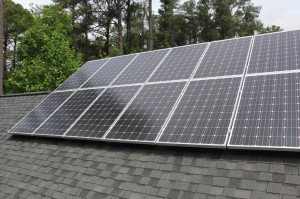Recently a neighbor asked about our home’s solar photovoltaic (PV) system. Since he’s not the first I thought I might write about our system, specifically a few things people might not know about PV systems. This reflects my experience and may differ from others. As always, your mileage may vary.
Solar PV is not rocket science. Solar PV literally once was rocket science, as one of its first practical applications was to power orbiting satellites. Apollo astronauts even left solar panels on the moon. Fortunately, a PV system no longer requires a NASA-sized budget nor an engineering degree. While the jargon may be confusing at first, you’ll quickly learn what’s what and things will start to make sense.
You don’t need the perfect roof. Sure, it would be great to have a roof facing due south with a pitch angle equal to your latitude and zero shading but you can still generate plenty of electrons in a “good enough” situation. Panels keep getting more efficient and new technology can adapt to shading to squeeze the absolute most efficiency out of any situation. Even on cloudy days! And when it comes right down to it, generating any electricity is better than not generating any at all.
Move along. Nothing to see here. I have the urge to show off my PV system to visiting friends but it soon dawned on me how … well, boring the system is. There are no moving parts to dazzle the curious, just a bank of shiny panels topside and a gently humming inverter. A PV system just works. Sun comes up, power gets made. Sun goes down, the PV system goes to sleep. It’s frankly easy to forget it’s there.
A push in the right direction. Unless you’ve got unlimited roof space or unlimited budget, chances are your solar PV system will only generate a portion of your total electricity demand. Big appliances like clothes dryers, air conditioners, and large kitchen appliances have huge electrical appetites and can quickly negate any gain your PV system might generate. Still as I said before, any electricity generated is better than none at all. Even if you still wind up writing a check to your power company, you can at least smile knowing that amount will be much smaller thanks to your PV system!
Here today, gone tonight. Most residential PV systems are know as “grid-tie” systems, meaning they’re linked to the electrical grid. Any power your PV system generates that your home doesn’t use goes out to power the neighborhood through the electrical grid. There’s no storage. I once thought a PV system would keep my lights on during a power outage but that’s actually not the case with a grid-tie system. In a grid-tie system, your PV system shuts down when your neighborhood goes dark. That’s to prevent a dangerous situation known as “islanding” where your PV system pumps power back into electrical lines that a power crew might otherwise assume were de-energized, potentially electrocuting them. While you can design a system which lets you go fully “off the grid,” batteries and chargers add cost and complexity to your PV system. And as most PV systems won’t fully cover your electrical demand it’s nice to have the grid available to cover any shortfall.
Changes in (sun) latitudes, changes in attitudes. Owning a PV system makes you very aware of your electrical habits. Our system came with an energy meter called an eGauge which displays in real time our electricity use and generation. It’s amazing how knowing this information changes our behavior. Appliances we once used with reckless abandon are now carefully managed. I can name the top five energy-hogging appliances in our home. The meter’s made me so aware of our energy I can actually tell by looking at it when a light bulb has been left on somewhere in the house. Just getting an energy meter can drastically alter your energy use and make you a greener household, all for a small fraction of the price of a PV system.
I hope you’ve found these PV tips useful. Look for more to come!
